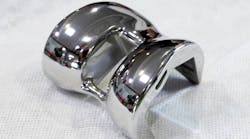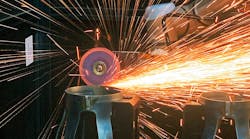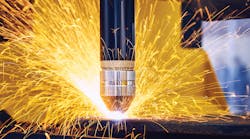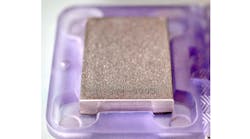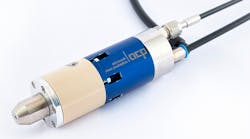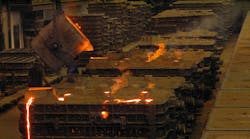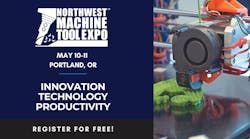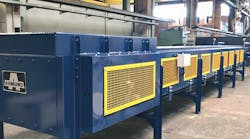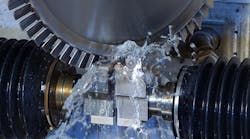With some obvious exceptions, nearly every casting is a precision part. That is, from the buyers’ point of view, the castings supplied for their manufacturing and/or assembly operations must meet and maintain established (and rising) dimensional and surface quality standards. The customer considers these to be precision parts, which is all that matters.
When the order involves many dozens or hundreds (or more) parts, the need for precision becomes a technical challenge for metalcasters. Lately, however, there is a range of process innovations for deburring and surface finishing, making it possible to improve product quality and process productivity.
In fact, surface finishing is an increasingly lively area of technical innovation. This is partly because producers seek to deliver burr-free components and workpieces with defined edges and fillets, or a surface finish that minimizes friction, wear and noise, and increases performance and service life. It’s also true that parts manufacturers want options for producing accurately shaped parts, and so the steps involved in grinding, machining, and surface finishing are converging. The challenge for metalcasters (and others) is to identify a finishing process that matches the part requirements and the need for productivity, with reliable and reproducible results.
Electrochemical machining — or ECM, in which cathodes are used to remove imperfections from the surface of a workpiece, is commonly used for finishing parts needed by aviation and aerospace, automotive, toolmaking, medical technology, microsystems engineering, energy systems, and other manufacturers. It’s compatible with high-volume operations.
This procedure makes deburring possible in difficult to access areas, such as internal bore intersections and pockets, and also permits burr-free shaping processes. The machining tool, namely the cathode, and the component (as an anode) are connected to a generator that serves as a direct voltage source for the machining process. The component is machined accurately, independent of the metal’s amorphous structure, by means of the charge exchange that takes place between the cathode and the anode in an aqueous electrolyte solution. This makes it possible to produce even very small, thin-walled contours, fillets, ducts, slots and washouts in workpieces made of practically any conductive metal.
Since processing is contact-free, the tooling is neither subject to wear due to the machining process, nor is it exposed to thermal or mechanical influences.
The characteristics and the shape of the tool holder determine where and how much material will be removed from the workpiece. Generator power is selected according to the size of the surface to be machined at any given point in time, and also determines the speed at which material is removed and the achievable degree of surface roughness. Newly developed generators reach Ra values of 0.1 µm and better, depending on the initial state. Beyond this, they also prevent so-called stray machining, which may lead to worse machining results at the anode’s peripheral areas.
ECM and precision electrochemical machining (PECM) are based on the same principle. Essential differences include the distance from the cathode to the workpiece on the one hand, and the use of an oscillating cathode in the PECM process on the other hand. Similar to electrical discharge machining (EDM), this makes it possible to produce extremely accurate three-dimensional shapes, contours, and structures with very high levels of surface quality. Ra values down to 0.03 µm can be achieved.
Compared to EDM, the PECM process is more accurate with regard to component dimensions and tolerances, and it imparts no thermal effects to the workpiece. Significantly reduced machining time is a further advantage of PECM, as opposed to conventional manufacturing. Comparisons, for which a component was produced by means of a conventional process involving spark erosion, milling, drilling, grinding, deburring and lapping, as well as a PECM process with subsequent grinding, reveal a 90% reduction in pure manufacturing time. In addition to shaping, PECM is used for micro-structuring of surfaces, for example in order to optimize tribological properties.
Additive manufacturing is spurring some developments in finish machining, because 3DP parts frequently have substandard surface quality. The new Coolpulse ECM process was specially developed for, surface finishing of 3D printed, metallic components. It is a single process capable of improving both micro and macrostructures on internal and external surfaces, and specified surface characteristics can be produced reliably with short cycle times. Also, support structure remnants and surface defects that may result from 3DP processes can be removed.
Abrasive flow machining — or AFM, is used primarily to process difficult-to-access workpiece areas and internal surfaces of high-quality components that cannot be processed by conventional procedures. Typical applications include rounding, polishing, and deburring, as well as geometry optimization and minimization of surface tension.
Workpieces are clamped into one or more fixtures at the AFM machine. Driven by hydraulically powered pistons, the processing medium – abrasive particles matched to the particular task with regard to type, size, and concentration, and are embedded in a polymer mass of defined viscosity – flows through or over the component(s) in alternating directions at a defined pressure level.
The grinding medium functions like a liquid file. Process parameters are continuously monitored in order to ensure reproducible results.
The AFM process makes it possible to improve surface roughness by a factor of five to eight, compared with initial surface condition. AFM is used to finish automotive parts, plastics, and aluminum industries, as well as in impression-die molds and tooling, tablet molds, and deep drawing dies. AFM is also used for surface-finishing medical and surgical parts, aviation and aerospace parts, and machine manufacturing.
New for barrel finishing — Surf, stream, and pulse finishing processes involve barrel-finishing methods for processing individual parts, which can be easily integrated into automated production. These developments are capable high-accuracy and reliable deburring, edge rounding, smoothing, grinding, and polishing of geometrically complex components, such as cutting tools and implants, as well as motor, gearbox and turbine components. While tasks like this usually have had to be completed manually, the new methods can be matched to manufacturing cycle times.
Pulse finishing involves matching the relative motion of the processing medium with the workpiece. For example, the workpiece is secured in a clamping collet and accelerated to a speed of up to 2,000 rpm, then decelerated and re-accelerated in a rotating bowl, all in a very short period. Interaction with the inertia of the processing medium (i.e., due to the different speeds of the workpiece and the abrasive particles) results in targeted grinding action with accurate deburring, even in areas that may have been inaccessible for barrel finishing, like cross-holes in hydraulic components.
Polishing with plasma — Like electropolishing, plasma polishing is an electrolytic process, but it works with high voltage and an electrolyte based on a salt solution that is ecologically harmless. The process results in the formation of plasma after the anodically polarized metallic workpiece has been immersed into the electrolytic bath. The plasma coats the workpiece, thus reducing surface roughness and removing organic and inorganic contamination, with a minimal loss of mass. Depending on the material specification, material abrasion typically lies between 2 and 8 µm per minute and achievable roughness values are less than 0.01 µm. The geometric shape of the component remains nearly unchanged.
DeburringEXPO —Technology for Precision Surface Finishing
Which processes ensure reliable and efficient deburring and production of precision surface finishes? Which new technologies are available? What criteria need to be considered for selecting an ideal process? Learn all this at DeburringEXPO at the Karlsruhe Exhibition Centre in Germany, Oct. 10-12, 2017. Learn more at www.deburring-expo.de.
